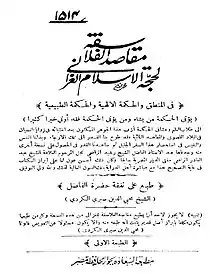The Aims of the Philosophers
Maqasid al Falasifa (Arabic: مقاصد الفلاسفة), or The Aims of the Philosophers was written by Abū Ḥāmid Muḥammad ibn Muḥammad al-Ghazali. Influenced by Avicenna's works, he wrote this book presenting the basic theories of philosophy.[1] In this book, he explained in detail about what philosophy is and described basic entities like judgement, concept, premise and logic. Al-Ghazali stated that one must be well versed in the ideas of the philosophers before setting out to refute their ideas. He also stated that he did not find other branches of philosophy including physics, logic, astronomy or mathematics problematic.[2][3] After writing Maqasid al Falasifa, he wrote another book Tahāfut al-Falāsifa, criticizing the Avicennian school of early Islamic philosophy.[4]
 | |
| Author | Al-Ghazālī |
|---|---|
| Country | Seljuk Empire |
| Language | Arabic |
| Subject | Philosophy |
Publication date | 12th century |
Influence
This book was influential in Europe and was one of the first to be translated from Arabic to Latin (12th century).[5] A portion of the book is also translated into Hebrew and English.[6] Muhammad Hanif Nadvi translated it into Urdu and is titled "Qadim Unani Falsafa" (Ancient Greek Philosophy).[7]
See also
References
- Juergensmeyer, Mark; Roof, Wade Clark (31 January 2018). Encyclopedia of Global Religion. SAGE. ISBN 9780761927297 – via Google Books.
- http://ghazali.org/books/chertoff.pdf
- Ghazali, Al (2000). The Incoherence of the Philosophers. Brigham Young UP. pp. 5–10. ISBN 0-8425-2466-5.
- electricpulp.com. "AVICENNA i. Introductory note – Encyclopaedia Iranica". www.iranicaonline.org.
- "al-Ghazali - Muslim jurist, theologian, and mystic".
- Ghazali, Imam. "Maqasid al-falasifah (Aims of the Philosophers) {مقاصد الفلاسفة} by Imam Ghazali - Maktabah Mujaddidiyah".
- M Awais Sultan (2021-02-07). QADEEM UNAANI FALSFA قدیم یونانی فلسفہ.